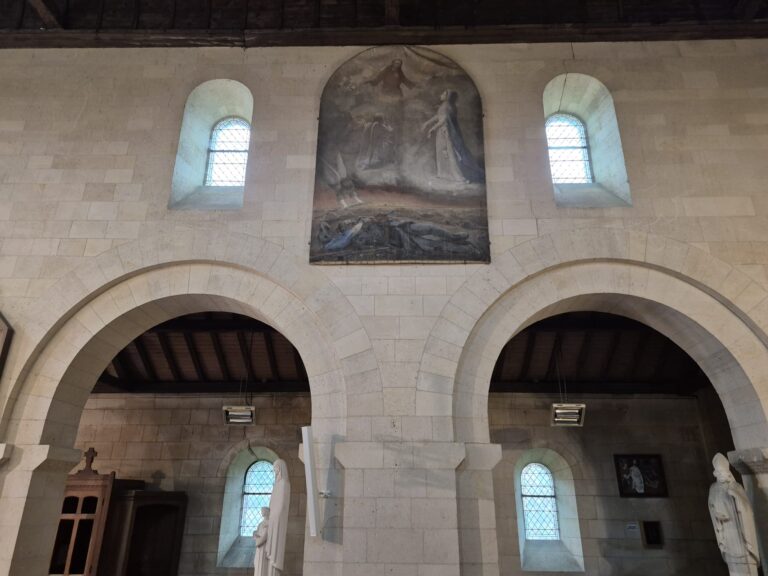[ad_1]

It’s a cloth of 3.10 meters by 2.10 which awaits its restoration. Suspended several meters high in the Saint-Éloi church of Tracy-le-Valon its left side upon entering, it began to reveal part of its mysteries.
“We don’t know much about it,” explains Hervé Lefranc of the Heritage meetings. The unsigned work also has no name. But its contents began to reveal themselves to observers when the association launched its first research three years ago.
A riddle to solve

Dated after the 14-18 war, it depicts a battlefield. “We see in the foreground a soldier dead of a bullet in the head, a French flag in his hands, a trench knife and a Lebel rifle at his side. Above, stands a winged angel undoubtedly bringing him the palms of victory. Behind, we can see the ruins of a castle and a burning cathedral. We can also see barrels near trenches. And at the very top, Jesus and Mary,” comments Hervé Lefranc, small red laser in hand, like a museum guide.
For the association and its members, the enigma has long been a puzzle that the association ASAPE 14-18, Underground of the Great War, of Moulin-sous-Touvent, has begun to resolve. “We first thought that it was a scene from 1918, but according to ASAPE the soldier is wearing a uniform from 1916. According to them, the cathedral on fire is that of Noyon, the ruins of the castle could be those of Carlepont,” explains Hervé Lefranc. And as for the mysterious barrels: “We did not understand why the painter wanted to represent barrels, but ASAPE links this to a known episode of barrel theft.”
For the heritage association, there are few doubts: “The scene represents a battlefield on the heights of Tracy, on the plateau,” explains Hervé Lefranc. A first victory.
But the work could well reveal a few more secrets during the upcoming restoration. The association has already brought a restaurateur on site. “She was able to observe the painting closely, and if she felt that there was no major work to be done to restore its shine, she is also positive about something else: the painting is not signed” , details the association.
A delicate operation
By dismantling the canvas in the coming weeks, the association’s volunteers hope “perhaps to discover the name of the author on the back, or even the title of the work.” The operation will in any case not be an easy task. “It obviously cannot be restored on site, so we will have to set up scaffolding, then take down the frame (we have already made sure that it is strong enough to hold up) and tilt it before taking it down” , explains the association. Knowing that the canvas culminates, at its peak, at 9 meters high, this will be anything but an easy task.
Then the painting will travel in a rental vehicle to the workshop of the restorer chosen for the job (in Compiègne). “It assures us that dusting and cleaning work will be sufficient” to restore the canvas to its former freshness, comments Hervé Lefranc. Work will begin on December 22. And should last three months.
Restore visibility to the web
For the return of the work to the church, the association has planned — “barring any major problems” — a return day on May 18. With the presence of veterans, blessing and revelation of the restored work. Everything should be accompanied by an exhibition on 14-18 and music. A moment the likes of which the listed Romanesque church has not experienced for ages. The faithful, and the inhabitants of the village, should discover a work that they had perhaps never seen before… despite its imposing size: “Many people tell us that they had never paid attention, it is so perched very high,” underlines Hervé Lefranc. Perched too high no doubt: the association already has the idea of hanging it a few meters lower. And to highlight it with plays of light.
But as nothing is free, and especially not the restoration which should cost the association around 6,000 euros of its subsidies, Les Rencontres du patrimoine has opened an online kitty. We can find it here. This furry one from the First War is probably worth it.

[ad_2]
Source link

